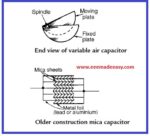Electrical Engineering Interview Questions and Answers: In this post, set 3 of Electrical Interview Questions is given.
Electrical Interview Questions
Why an ac solenoid valve attract the plunger even though we interchanges the terminal?
Will the poles changes?
Answer: Yes because the poles changes for every half-cycle of ac voltage so the polarity of AC
voltage is continuously changing for every half cycle.
So, interchanging of terminals in ac system does not show any difference. That’s why the ac solenoid attract the plunger even though its terminals are interchanged.
Download & Install EEE Made Easy App
What is derating? Why it is necessary, is it same for all means for drives, motors, and cables?
In Electrical Engineering, derating means lowering the electrical capabilityof electrical apparatus.
An equipment or component is designed for standard or set environment conditions and presuming proper ventilation.
If temperature of surrounding goes up , or if the component is required to work at different temperature, humidity, enclosures, pressures or any conditions deviating from its range, it will not be able to work to its full capacity.
To indicate to what extent the component may be stressed/ used in such conditions, a factor, known as derating factor, is specified.
for cables, the derating factor depends on ambient temperature and how you are laying the cable i.e. in Air,Duct,Burried.
Normally the current carring capacity of a perticular cable is calculated at 400c, but if u lay the cable in air then it includes the temparture around it, if it increases more the 400c then the conductor gets heated up by increasing the resistance in it thus the current carring capacity of a given cable decreases, so we will derate the cable.
What is Automatic Voltage regulator (AVR)?
Answer: AVR is an abbreviation for Automatic Voltage Regulator. It is important part in
Synchronous Generators, it controls the output voltage of the generator by controlling its
excitation current. Thus it can control the output Reactive Power of the Generator.
What is an exciter and how does it work?
Answer: There are two types of exciters, static exciter and rotary exciter. Purpose of exciter is to supply the excitation dc voltage to the fixed poles of generator.
Rotary exciter is an additional small generator mounted on the shaft of main generator. If it is dc generator, it will supply dc to the rotary poles through slip ring and brushes (conventional alternator).
if it is an ac exciter, output of ac exciter is rectified by rotating diodes and supply dc to main fixed poles.ac exciter is the ac generator whose field winding are stationary and armature rotates.
Initial voltage is built up by residual magnetism. It gives the starting torque to the generator.
Difference between a four point starter and three point starter?
Answer: The shunt connection in four point stater is provided separately from the line where as
in three point stater it is connected with line which is the drawback in three point stater
Why use the VCB at High Transmission System? Why can’t use ACB?
Answer: Actually the thing is vacuum has high arc quenching property compare to air because in VCB, the die electric strengths equal to 8 times of air. Thats why always vacuum used as in HT breaker and air used as in LT.
What is the difference between surge arrestor and lightning arrestor?
Answer: Lightning Arrester is installed outside and the effect of lightning is grounded, whereas surge arrestor installed inside panels comprising of resistors which consumes the energy and nullify the effect of surge.
Why synchronous generators are used for the production of electricity?
Answer: synchronous machines have capability to work on different power factor (or say
different imaginary POW varying the field emf. Hence syn. generators r used for the production
of electricity.
Enlist types of dc generator?
Answer: D.C. Generators are classified into two types
1) Separately excited d.c.generator
2) Self-excited d.c.generator, which is further classified into; 1) series 2) shunt and
3) Compound (which is further classified into cumulative and differential).
What is the difference between synchronous generator & asynchronous generator?
Answer: In simple, synchronous generator supply’s both active and reactive power but
asynchronous generator (induction generator) supply’s only active power and observe reactive
power for magnetizing. This type of generators are used in windmills.
Give two basic speed control scheme of DC shunt motor?
Answer: 1. By using flux control method: in this method a rheostat is connected across the field
winding to control the field current.
so by changing the current the flux produced by the field winding can be changed, and since speed is inversely proportional to flux speed can be controlled.
Armature control method: in this method a rheostat is connected across armature winding by
varying the resistance the value of resistive drop (IaRa) can be varied, and since speed is directly proportional to Eb-IaRa the speed can be controlled.
What is the principle of motor?
Answer: Whenever a current carrying conductor is placed in a magnetic field it produce turning
or twisting movement is called as torque.
What is meant by armature reaction?
Answer: The effect of armature flu to main flux is called armature reaction. The armature flux
may support main flux or opposes main flux.
Read Also: Armature Reaction in DC Machines|Cross Magnetization and Demagnetization
What is the Polarization index value? (Pi value) and simple definition of polarization
index?
Answer: Its ratio between insulation resistance (IR) i.e. meggar value for 10min to insulation
resistance for 1 min. It ranges from 5-7 for new motors & normally for motor to be in good
condition it should be Greater than 2.5.
Polarization Index Test (PI) – The PI test measures the ability of the insulation to absorb voltage over a period of time.
This gives an indication of the overall insulation quality of the individual pieces of insulation in the transformer.
This test is usually performed in conjunction with the Meggar Test. It is measured as ratio of insulation resistance (IR) for 10 minutes to insulation resistance for 1 minute.
What will happen when power factor is leading in distribution of power?
Answer: If there is high power factor, i.e. if the power factor is close to one: Losses in form of heat will be reduced, Cable becomes less bulky and easy to carry, and very cheap to afford, & It also reduces over heating of transformers.
More on Electrical Interview Questions
- Electrical Engineering Interview Questions|Basic Electrical Engineering Questions & Answers
- Electrical Engineering Important Interview Questions and Answers
- 30 Electrical Engineering Interview Questions & answers- Set 1
- Basic Electrical Engineering Questions and short Answers
- Sub Engineer KSEB Interview Questions
- [Set 2]Electrical Engineering Interview Questions and Answers|Electrical Engineer Interview Questions and Answers
- [Set 3] Electrical Engineering Interview Questions and Answers| Electrical Interview Questions
- [Set 4]Electrical Engineering Interview Questions|Electrical Questions and Answers
- Electrical Power System Problems and Solutions
- AE KSEB Interview Questions|Basic Electrical Engineering Interview Questions
Latest Posts
Latest Posts in EEE Made Easy
- RRB JE CBT 2 Exam Date 2025 Postponed|RRB JE CBT 2 Exam Date
- [PDF]RRB JE Result 03/2024 Cut off, Selected no of candidates for all regions
- [PDF]Final Answer Key Junior Instructor Mechanic Agricultural Machinery|643/2023 Solved Question paper
- Acoustics MCQs|Industries Extension officer|IEO 2025
- LASER MCQs| Industries Extension officer|IEO 2025
- Practical Types of Capacitors
- [PDF] Syllabus JUNIOR INSTRUCTOR MECHANIC AGRICULTURAL MACHINERY|643/2023 Syllabus Kerala PSC




